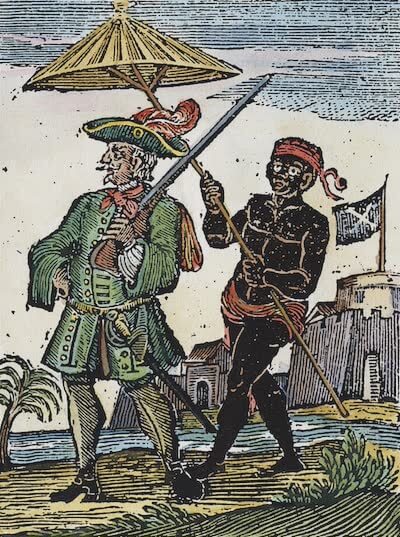
Henry Avery was one of the most successful pirates of all time in terms of the plunder he accumulated, despite only being active for two years. Not much is known about his early life, but it is commonly accepted that he was born in 1659 in the West Country of England, probably in Newton Ferrers, a village about six miles south-east of Plymouth, Devon. The more common spelling of Avery’s surname is Every. He was also known under several alias including Long Ben and Benjamin Bridgeman.
He joined the English Navy, although the exact year is unknown. He is recorded as working as a midshipman aboard a sixty-four-gun ship named the HMS Rupert, under Captain Francis Wheeler and possibly participated in the Nine Years War, but was probably a seaman long before then. After being discharged from the Royal Navy he began working as an illegal slave trader in Africa, although this part of his life is not well documented. In 1693 he is recorded as participating in a privateering expedition sponsored by London investors and the Spanish King. Avery was to be the first mate on the ship Charles II, but due to a dispute over unpaid wages seized the ship together with twenty-five other crewmembers. His crew gradually increased in size.
Avery started his piratical career by capturing two British merchant ships off the coast of the Cape Verde Islands and raiding an African tribe on the coast of Guinea before sailing to Madagascar in early 1695, where he captured a French pirate ship. Henry Avery always made it clear that it was not his intention to attack English ships, even leaving a note for the East India Company in Anjouan expressing his sentiment.
In August of 1695 Avery captured his greatest prize, the Ganji-i-sawai, know in English as the Gunsway, an Indian ship returning from the annual pilgrimage to Mecca. Together with five other pirate ships, including one commanded by Thomas Tew, he ambushed the Mughal fleet of twenty-five ships. After a long chase they finally caught up with the fleet and captured the larger Ganji-i-sawai and its escort the Fateh Muhammed with few losses to themselves. The 1,600 ton, 80-gun Indian ship was crippled by a lucky shot which took out its main mast and one of its cannons exploding, causing confusion and chaos on board. The treasure the pirates seized on that fateful day is thought to have been as much as £600,000 in precious metals and jewels, an astronomical sum in those times. Unfortunately, the success was marred by the abhorrent actions of the victors, including murder and rape. After their success the pirates went their separate ways with each taking about £1000 as his share, much more than seaman could dream of making in a lifetime. As the Mughals were important British trading partners Avery and his men became the first known public enemies of the British Empire. Despite that, only a twenty-four of the pirates were ever apprehended, four of whom were later hanged for their crimes.
Next Avery and his remaining crew sailed on the Fancy, heading for Nassau in the run-down British colony of New Providence in the Bahamas, using their loot to purchase slaves along the way. Avery, under the name of Captain Bridgeman, rested there for a while with his men after bribing the governor of the colony, even handing the Fancy over to him. Avery’s crew probably split up at this point to avoid the international manhunt being led by the British government and East India Company, and there is much speculation about his fate. Avery’s last known movement was in June of 1696 when he and his remaining crew sailed aboard a sloop named Sea Flower heading towards Ireland. Theories include:
- According to Captain Johnson Avery died in poverty in Devon, England, after attempting to sell his diamonds, being cheated out of his wealth by Bristol merchants.
- Avery changed his name and settled in Devon to live out the rest of his life peacefully.
- Avery lived as a king married to an Indian princess in the fabled pirate kingdom of Libertalia on the island of Madagascar. The first such account appeared as a 16-page pamphlet titled The Life and Adventures of Capt. John Avery; the Famous English Pirate, Now in Possession of Madagascar in 1709.
While there were many alleged sightings and the manhunt continued for a decade after his disappearance no one ever heard from Henry Avery again after this point. It is generally unknown what the King of Pirates truly did with his untold fortune.
For more information on Henry Avery check out the website Golden Age of Piracy.
An interesting two part history on Avery and his exploits from the Youtube channel The Crewe of the Fancy.

My great great great etc etc grandad
😊🍺